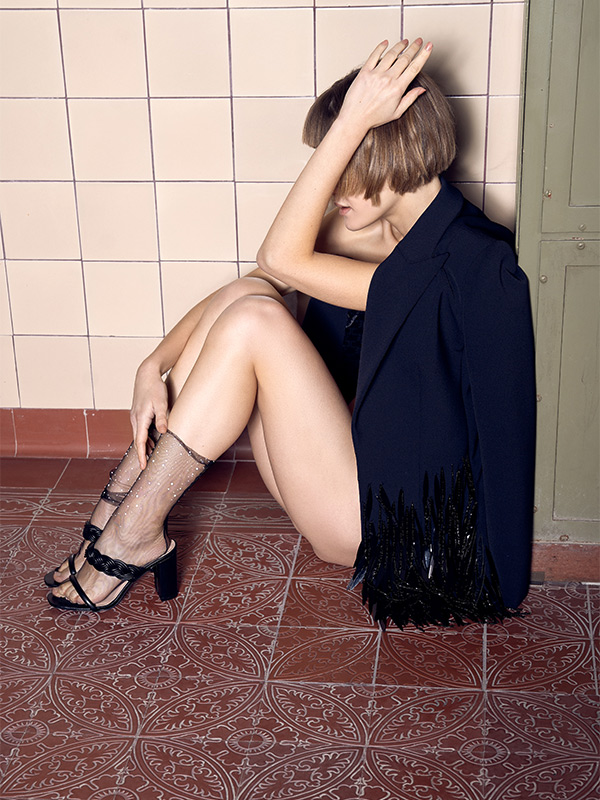American artist Frank Ockenfels 3 stages the A-league of stars like nobody else does. Instead of portraying them in a clean and boring way, he throws his personal diaries, collages and paintings into the mix. Since the 1980s, he has been proving that art needs neither rules nor expensive equipment, but ideas, hands-on work and uninhibited self-expression. With the exhibition “Frank Ockenfels 3: Introspection”, Fotografiska Berlin invites you to indulge in the untamed Ockenfels universe. In this interview, Frank Ockenfels himself tells us whether it makes him nervous that photographing Hollywood stars is part of his everyday business and whether the world really was better in the past.

FACES: It seems like everyone has already stood in front of your lens. Is there someone you really want to photograph but haven’t managed to do so yet?
Frank Ockenfels: One name immediately comes to mind – Daniel Day-Lewis. His face becomes more and more expressive with age and I admire the depth in his features. It would be a dream to capture that. Also Ralph Steadman, the artist, because of the unique experience. There’s something about their faces, their presence, that I want to explore through my lens.
F: Who was the funniest person you’ve ever photographed and why?
FO: Rami Malek, definitely. What a fantastic face! And he’s so open to collaboration. We had an instant chemistry where he brought 100 percent of himself to the moment. We just created without thinking too much. This spontaneity made the shoot unforgettable.
F: Do you need a close personal relationship with your subjects or is it easier to photograph someone you don’t know well? Or does it depend on the person?
FO: It really depends on the moment. What I enjoy most is the connection in the here and now. It’s about the portrait we create together in the moment – with the environment, the light and the conversation. If you approach it with preconceived ideas or an agenda, the focus shifts to you, not the subject. The best portraits are created when everything flows together in the moment.
F: In the early years of your career, were you ever nervous about photographing famous people – for example, when you had David Bowie in front of your lens?
FO: I only remember one situation where I was nervous – with Richard Serra. He is one of my heroes and I was commissioned to photograph him. When I arrived at his studio, he gave me precise instructions on how to photograph him. I was quite nervous, but my wife, who was with me, nudged me and told me to get out of my head. So I didn’t follow his instructions and it turned out better than I could have ever imagined.


“The best art is created through experience, through doing, through failure.”
F: What is your favorite memory of some of your most famous portraits? Are there any unforgettable behind-the-scenes moments that you like to think back on?
FO: One of my favorite scenes was with David Lynch. He greeted me at the door with a cup of coffee and showed me into his office. He turned to me and said, “When I’m done with my coffee, you’re done.” It was so playful and intense at the same time. We created something special in that short time, and I loved the challenge he set with each photo. There is always a creative collaboration with people like him.
F: Which is your camera of choice?
FO: It used to be my Super D Graflex, but they don’t make film for it anymore. Now I find old lenses that I attach to digital cameras. For me, it’s not about the camera, it’s about what I can capture in that fleeting moment.
F: You are known for working with minimal equipment. Is camera equipment too complex these days? Is everything too perfected to have any fun at all?
FO: For me it’s simple – less is more. I don’t believe you need a lot of equipment to create something meaningful. In fact, I often look for the flaw, the strange light that appears unexpectedly. That’s where the magic lies. Perfection? That is overrated. The beauty lies in imperfection.
F: Do you remember the first time you held a camera in your hand? What was the first photo you took?
FO: I was about eight years old and held my mother’s Instamatic camera in my hands. I remember photographing shadows – just this simple, innocent discovery of light and form. I never thought it would lead me to where I am today. But that’s how it all started – in the small, quiet moments.
F: You’ve been in this business for decades – what do you miss about the good old days?
FO: Photography is now a production – hair, make-up, styling, permissions. I used to just ring the doorbell with a bag full of cameras. Spontaneity was the decisive factor. I miss that originality. But I also know that you should never say “never” – there are still moments when that simplicity comes back.
F: What advice would you give to young artists? And what to your younger self?
FO: Always create what you see. That’s why they hired you – because of your unique perspective. My younger self? I would say don’t worry so much about the outcome. Keep creating, keep failing and learn from it. That’s the journey.


“AI has no soul… At least not yet.”
F: You are probably a hero to many aspiring artists. Who are your heroes?
FO: Well, Francis Bacon, Anselm Kiefer, Basquiat, Ralph Steadman, Irving Penn, Erwin Blumenfeld and, more recently, William Kentridge. These people have shaped my vision. Their works challenge me to go further.
F: Is there new blood in the photography scene that inspires you? Or has it all been there before?
FO: There’s always fresh blood. It’s about wandering around and seeing what’s right in front of you – be it a piece of art, a piece of paper or simply the play of light. Inspiration is everywhere – if you’re open to it.
F: What does the current state of the world do to you – are you optimistic or pessimistic?
FO: I think about it a lot. It makes me sad how much the fear of change and the lack of understanding of our past characterize us. But art, as always, will move us forward. It has the power to challenge, reflect and guide us.
F: How exactly does art help us through difficult times?
FO: Art has always been there, in the darkest moments. You only have to look at history and you will see it. It helps us to process, reflect and find our way through the chaos.
F: Is it becoming increasingly difficult to develop new ideas? Is the world too difficult for creativity, or is the opposite the case: are difficult times creating more new ideas?
FO: Difficult times awaken ideas. Like the return of grunge in music – people are looking for the flawed edges, the rawness that they can identify with. Art comes from the struggle, the imperfections.
F: With AI-generated images everywhere, do you think people will abandon handmade images or demand them even more precisely because of the “artificiality” of AI?
FO: AI has no soul… At least not yet. It’s not real, like human-made art. I think people will look for the authenticity, the flaws, the soul that comes with the human touch. There’s something deeper in these paintings that AI can’t imitate.
F: So you’re not a big fan of AI?
FO: I think it has potential, but it still lacks something fundamental. As I said, it doesn’t have a soul that brings art to life – yet.
F: What’s the biggest lie people believe about photography?
FO: Photography is not about the equipment. It’s about capturing light. That’s the essence. People often overlook the fact that it’s not about the technique, it’s about seeing the light and translating it into something meaningful.


“I’m never sure whether a picture has an end.”
F: When did you start writing diaries? And when did you start using them in your art?
FO: It started as a way to clear my head, to organize my thoughts after a shoot. I would sit on airplanes, write down thoughts, stick Polaroids to them. Over time, it became a way of recording how I lit images. It wasn’t until later that I started using it as an art form, but it was never really about the art. It was a way of expressing what I saw.
F: What do your photos say about you that words never could?
FO: My photos show that I am always learning, always experimenting. They say that I’m constantly trying new things, pushing boundaries and capturing light in ways that words can’t explain. They speak for me without saying a single word.
F: Do you already have a finished image in mind when you make a portrait or does everything flow together spontaneously, as with collages and journaling?
FO: I’m never sure if a picture has an end. It flows as it happens, and sometimes it evolves into something completely different. I let the moment dictate the direction.
F: You once said in an interview that you had a degree in photography, but that it didn’t really mean anything. Is the best art self-taught?
FO: Studying helps, but it’s only a tool. The best art comes from experience, from doing, from failure. Studying gives you the time and space to work on your vision, but it’s the constant learning and unlearning that shapes you as an artist.
F: What “rule” of photography do you like to break?
FO: I love to break the “perfect lighting” rule. I find beauty in imperfection, in chaos. It’s about finding something unexpected, something raw.
Q : A few quick questions at the end: digital or analog?
FO: No matter – whatever I have in my hand.
Q: Camera or cell phone?
FO: Here too: Whatever I have in my hand.
Q: Color or black and white?
FO: Black and white.
Q: Keep a diary or take photos?
FO: Keeping a diary because it leaves more room for mistakes.
Q: Chaos or control?
FO: Chaos.
Q: Handmade or digitally processed?
FO: Handmade.

Frank Ockenfels 3
Rules are there to be broken. Frank W. Ockenfels III, known as Frank Ockenfels 3, has been doing exactly what he feels like doing for decades. He mixes excerpts from personal diaries with collage, photography and painting. His uniquely playful and spontaneous approach has attracted the likes of David Lynch, Angelina Jolie and Milla Jovovich to his lens. Incidentally, these do not have to be of the very best brand: Frank Ockenfels celebrates imperfection and the approach of using whatever material is available. In his career to date, he has created over 200 album covers – including everything from Alice in Chains to Neil Diamond – countless advertising campaigns and film posters for hit shows such as “Breaking Bad” and “Homeland”.
fwo3.com

Frank Ockenfels 3: Introspection
Anyone strolling through the Fotografiska in Berlin will come across one familiar face after another. There are the boys from Nirvana, David Bowie is looking in all directions, over there several George Clooneys are grinning side by side. And scraps of text from diaries, color and collages creep into the portraits again and again. Welcome to the world of Frank Ockenfels 3, which you can immerse yourself in at Fotografiska Berlin until May – ideally with a healthy dose of curiosity and love for the imperfect. Frank Ockenfels 3: Introspection, Fotografiska Berlin, Oranienburger Straße 54, Berlin until May 4, 2025 berlin.fotografiska.com
Here you can find everything about Frank Ockenfels 3’s exhibition at Fotografiska Berlin.
Photos: © Frank Ockenfels 3
Director Yorgos Lanthimos also creates unique photographic worlds.








